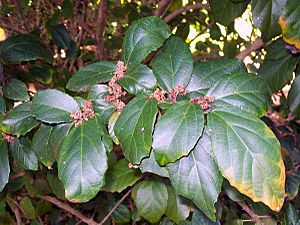Green kamala facts for kids
Quick facts for kids Green kamala |
|
|---|---|
 |
|
| Mallotus claoxyloides | |
| Scientific classification | |
| Genus: |
Mallotus (plant)
|
| Species: |
claoxyloides
|
| Synonyms | |
|
|
The Mallotus claoxyloides is a fascinating plant from the Australian rainforest. It belongs to the spurge family, which is a large group of plants. You might know it by its common names like green kamala, odour bush, or even smell of the bush.
This plant is famous for its strong scent. Some people think it smells a bit like a skunk, which isn't very pleasant! But many others find its smell to be quite nice and sweet. Because of its unique smell, people sometimes grow it in their gardens.
The name claoxyloides means that its leaves look similar to another plant called Claoxylon. You can find this plant growing naturally from the Richmond River in New South Wales all the way up to the Torres Strait in the north-east of Australia. It likes to live in the drier parts of eastern Australian rainforests. It's also a helpful plant for nature, as it grows quickly in areas that have been disturbed, helping the forest to grow back.
What Does it Look Like?
The green kamala can grow as a bush or a small tree. It can reach up to 11 metres (about 36 feet) tall, and its main stem can be about 23 centimetres (about 9 inches) wide. The trunk often looks a bit bent or crooked. Its bark is usually smooth and grey or greenish-grey. You might notice some small bumps on the bark, sometimes even in a straight line.
The smaller branches are brown and green. Their tips are often soft and fuzzy, with reddish-brown bumps.
Leaves
The leaves of the green kamala grow in pairs, opposite each other on the stem. They are usually between 5 to 12 centimetres (2 to 5 inches) long and 3 to 6 centimetres (1 to 2.5 inches) wide. Their shape can vary, but they are mostly oval or elliptical. Sometimes, the base of the leaf can even be shaped like a heart! The edges of the leaves can be smooth or have small teeth.
If you look closely at the top part of the leaf, near where it connects to the stem, you might see tiny glands. The leaf stalks (the small stems that connect the leaf to the branch) are covered in short hairs and can be different lengths, from 5 millimetres to 40 millimetres. Just like its relative, the red kamala, this plant has two main veins at the base of the leaf. These veins can extend up to a third or even half of the way up the leaf. If you turn the leaf over, you can easily see a network of smaller veins.
Flowers, Fruit, and Reproduction
The green kamala produces greenish-yellow flowers. They grow in clusters and appear from October to March. An interesting fact about this plant is that male and female flowers grow on different trees. This means you need both a male and a female tree for them to reproduce! The female flowers don't have any petals.
The fruit of the green kamala is a brown capsule. It ripens between February and June and is about 13 millimetres (about half an inch) wide. The capsule is covered in tiny bristles. When it's ready, it splits open into two parts, and inside each part, you'll find a single, round, grey seed.
Growing new plants from fresh seeds is usually very successful. You can also grow new plants from cuttings, which means taking a piece of the plant and helping it grow roots.

